
Convenience Stores: Nicotine Addiction Central
 An army of 140,655 U.S. convenience stores has become the tobacco industry's key partner in enticing children and teens to smoke nicotine, in providing the cigarettes that enslave them, in servicing their chemical dependency into adulthood, in keeping them hooked for life, in foiling their attempts to quit and in encouraging them to relapse.
An army of 140,655 U.S. convenience stores has become the tobacco industry's key partner in enticing children and teens to smoke nicotine, in providing the cigarettes that enslave them, in servicing their chemical dependency into adulthood, in keeping them hooked for life, in foiling their attempts to quit and in encouraging them to relapse.
This article lays out some things you may not know about nicotine addiction, young people and convenience stores. It seeks to motivate convenience stores to take immediate steps to insulate young minds from irresponsible marketing. It also seeks to empower students to organize campaigns to stop neighborhood youth tobacco marketing.
Nicotine Highly Addictive
Nicotine is more addictive and harder to beat than heroin or cocaine. The convenience store industry cannot escape the reality that 67.8% of new nicotine smokers are age 17 or under, that a middle school student entering a convenience store at least once a week has 50% greater odds of smoking, or that among 12 to 17 year-olds who have smoked in the past 30 days more than half (53.3%) report personally purchasing cigarettes at least once in the past month.
The store industry knows that a frightening percentage of youth begin losing their autonomy within the first few cigarettes, that their de-sensitized brains will grow millions of extra nicotinic receptors in at least eleven different regions, and that 86.8% of students who smoke nicotine at least once daily are already chemically dependent under DSM-IV nicotine dependency standards.
Nicotine Addiction Industry Invades Neighborhoods
The neighborhood chips, soda and candy store wasn't always the nicotine addiction industry's leading partner. Slow moving, haphazard and short sighted tobacco control regulation compelled "Big Tobacco" to retreat into America's neighborhoods.
In 1970 the cigarette industry spent 69% of all marketing on television and radio commercials. In 1971 Congress banned TV and radio ads and the industry quickly shifted those dollars into print. By 1976 magazine, newspaper and billboard advertising accounted for 63% of marketing, and no more than 20% was being spent in neighborhood stores.
In 1998 the Master Settlement Agreement (MSA) between 46 states and all major U.S. cigarette makers banned tobacco ads in outdoor billboard adverting, transit, and magazines with high youth readership. The cigarette industry's 1998 total marketing budget was then $6.7 billion. Within five years it would double.
According to the Federal Trade Commission's 2005 "Cigarette Report," in 2003 the cigarette industry spent less than 2% of its record $15.1 billion marketing budget on magazine, newspaper and Internet marketing, while pumping $12.2 billion (80%) of all marketing dollars into neighborhood stores.
Convenience Stores Aggressively Targeting Teens
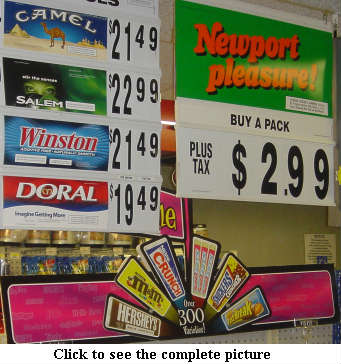 In 2005 the National Association of Convenience Stores (NACS) co-authored a 43 page study entitled "Convenience Teens - Building Loyalty with the Next Generation." It asserts that two-thirds of teens age 16 to 20 are convenience store shoppers (convenience teens), that convenience teens visit 14% more often than shoppers over 30 years of age, that a teen's purchase value is 99% of that of over 30 shoppers, and that teens shop the rest of the store more than older shoppers do.
In 2005 the National Association of Convenience Stores (NACS) co-authored a 43 page study entitled "Convenience Teens - Building Loyalty with the Next Generation." It asserts that two-thirds of teens age 16 to 20 are convenience store shoppers (convenience teens), that convenience teens visit 14% more often than shoppers over 30 years of age, that a teen's purchase value is 99% of that of over 30 shoppers, and that teens shop the rest of the store more than older shoppers do.
The study says "satisfying a craving" is the second most cited motivation for teens visiting a store, with candy and cigarettes as two types of cravings teens seek to satisfy. The report asserts that, while candy is what 81% of teens "usually" buy, 27% of teens "usually" purchase cigarettes or other tobacco products.
The report states that "when teens talk about why they choose a particular c-store over other options, they talk about the nice people, a sense of belonging, and cashiers who know them by name or are '[their] friend.' " Many see stores as a place for "hanging-out."
The NACS report openly acknowledges that teens are at a "crucial stage of the learning curve," that "they make mistakes," that "they watch and learn from others," "that they're still trying to figure things out," and that "because teens are at the beginning of this process, retailers have an important opportunity to connect."
Stores Knowingly Assault Immature & Developing Minds
A $12 billion marketing make-over has transformed what was once the neighborhood candy store (and still today makes over $4 billion in annual candy sales) into Nicotine Addiction Central. Today, a child who goes in to satisfy a sweet tooth is engulfed in a tsunami of brightly colored nicotine product marketing that distorts all perceptions about the use, social acceptance, purpose, safety and popularity of nicotine products.
According to the U.S. Centers for Disease Control (CDC), 75% of teenagers enter a convenience store at least once weekly. Their average visit is 16 minutes, twice as long as an adult's. During that time, the nicotine delivery industry will assault their mind from many directions and with many ploys.
 According to the CDC, 59% of convenience stores don't wait for youth to enter their doors before attacking. They use exterior and window signs and daily beam invitations to smoke earth's most captivating chemical to young people on school buses, bikes and walking on neighborhood sidewalks. On average tobacco retailers display 2.4 exterior advertisements but among retailers employing exterior signs 40.4% use 5 or more.
According to the CDC, 59% of convenience stores don't wait for youth to enter their doors before attacking. They use exterior and window signs and daily beam invitations to smoke earth's most captivating chemical to young people on school buses, bikes and walking on neighborhood sidewalks. On average tobacco retailers display 2.4 exterior advertisements but among retailers employing exterior signs 40.4% use 5 or more.
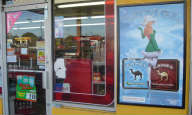 As youth approach the store entrance, enticing words and artwork tell them that adults smoke Camels for adventure, Kools to be real, Newports for pleasure, Marlboros for flavor or discount brands for price. As they open the door, they are assaulted by an average of 17 signs suggesting that smokers smoke for every reason imaginable except for the true reason - because they must, because they are true drug addicts and escalating anxieties hurt when they don't get the nicotine fix their bodies require. According to the 2004 National Survey on Drug Use, 37.3 million Americans above age eleven are daily smokers and that 35.3 million smokers meet criteria for chemical dependence upon nicotine.
As youth approach the store entrance, enticing words and artwork tell them that adults smoke Camels for adventure, Kools to be real, Newports for pleasure, Marlboros for flavor or discount brands for price. As they open the door, they are assaulted by an average of 17 signs suggesting that smokers smoke for every reason imaginable except for the true reason - because they must, because they are true drug addicts and escalating anxieties hurt when they don't get the nicotine fix their bodies require. According to the 2004 National Survey on Drug Use, 37.3 million Americans above age eleven are daily smokers and that 35.3 million smokers meet criteria for chemical dependence upon nicotine.
Once inside, youth stand on the front line of a $12 billion dollar tobacco industry battlefield where they are both victim and prize. It's a brand awareness war where combatants battle to rein supreme in permanently hooking as many youth as early as possible. It's a war in which defeat will soon cost the average enslaved mind more than $1,000 per year.
We Card Program - Youth Enticement & Responsibility Facade
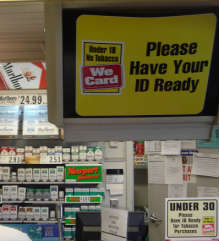 Above the counter is a large yellow sign that's almost impossible to miss. It reads "Under 18 No Tobacco - We Card." This is the cruelest deception of all. Masquerading as a vehicle to discourage underage smoking, the "We Card" sign actually reinforces the perception that smoking is a desirable grownup activity.
Above the counter is a large yellow sign that's almost impossible to miss. It reads "Under 18 No Tobacco - We Card." This is the cruelest deception of all. Masquerading as a vehicle to discourage underage smoking, the "We Card" sign actually reinforces the perception that smoking is a desirable grownup activity.
According to a draft of Philip Morris USA's Archetype Program Summary, "an archetype is a mental highway (neuronal pathway) which has been imprinted at an early age and is used each time we perform an action. The first imprinting of smoking is that adults do it, and I'm excluded." An outline version of the Summary asserts that smoking is part of the "coming of age process" that involves both "imprinting/awareness" and "a rite of passage." "Smoking is a means of establishing one's own adult identity," an "initiation into adulthood" and it is "essential for smoking to remain" an "adult activity."
In addition to using adulthood as bait, the "We Card" program creates a corporate responsibility facade that fends off enactment of meaningful youth smoking prevention legislation, including the prospect of serious sanctions for sales to minors. Only 17 states require stores to check age identification, 15 actually allow minors to possess tobacco products, and few fund serious ongoing enforcement of existing laws.
Combining Color, Candy & Convenient Cigarettes
Behind the sales counter screams a carefully orchestrated power-wall of colorful boxes, packs and cartons that overwhelmingly reflect the product line of the tobacco company willing to pay the store the highest promotional allowance at the time of contract.
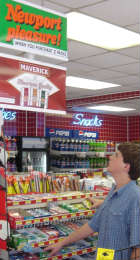 An alarming percentage of convenience stores accept payment for allowing tobacco companies to hang marketing messages above candy and pastry racks. Although Section III of the 1998 MSA prohibits the direct or indirect targeting of youth, the nation's Attorneys General continue to ignore sign placement.
An alarming percentage of convenience stores accept payment for allowing tobacco companies to hang marketing messages above candy and pastry racks. Although Section III of the 1998 MSA prohibits the direct or indirect targeting of youth, the nation's Attorneys General continue to ignore sign placement.
How many invitations to smoke nicotine can be safely imprinted upon a child's brain before their cumulative impact culminates in that one fateful "what the heck" moment?
Whose responsibility is it to battle for the neurochemical freedom of America's youth? Why do parents, teachers and local officials fail to appreciate that just down the street the most effective drug addiction campaign America has ever known is working around-the-clock to condition neighborhood youth to believe that they have not experienced true pleasure or real flavor until they've smoked nicotine?
A 2004 study found that two-thirds of students visit a small store on their way to or from school at least once weekly. A 2005 study found that the density of convenience stores is greatest in poorer neighborhoods. The result is higher levels of dependency among those least able to afford nicotine.
$364,446 in Nicotine Sales Per Store
In 2004 cigarettes continued their reign as the top in-store sales category generating 34.7% of all in-store convenience store sales. Cigarette sales during 2004 generated $45 billion dollars or an average of $331,000 per store location. In addition the average store also sold $33,460 in other tobacco products - primarily oral tobacco.
According to the National Association of Convenience Stores the "convenience store industry has been extremely successful in garnering market share in cigarettes from other retail formats."
Where the "Do Nothing" Option Takes Us
What can youth groups, parents, educators, civic leaders and local officials do to insulate young minds from the irresponsible marketing of a chemical that when smoked is nine times (90% - DSM III standards) more addictive among regular users than alcohol (roughly 10%) and five times more captivating than cocaine (roughly 17%)? What will happen if nothing is done?
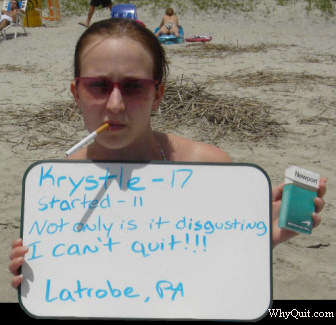 Ignoring neighborhood nicotine marketing invites continued escalation: we can expect new and tastier nicotine delivery vehicles and more effective ad campaigns. Continued shotgun type marketing that does not avoid the young, gullible and immature (indeed, goes to the very places where teens hang out) will doom yet another generation to a lifetime of battling to break nicotine's grip upon their mind, health and life.
Ignoring neighborhood nicotine marketing invites continued escalation: we can expect new and tastier nicotine delivery vehicles and more effective ad campaigns. Continued shotgun type marketing that does not avoid the young, gullible and immature (indeed, goes to the very places where teens hang out) will doom yet another generation to a lifetime of battling to break nicotine's grip upon their mind, health and life.
Both the tobacco and pharmaceutical industries are now moving toward less damaging but just as profitable forms of nicotine dependency. I am not referring to lower tar and nicotine, "light," or "mild" cigarettes, which attract youth but are just as deadly. In fact, in that Philip Morris' Archetype Program asserts that some degree of "risk" and "danger" are youth enticement factors and its website openly proclaims "there is no safe cigarette" (a risk hiding slogan).
The smoke-free indoor air movement is now at hurricane force and sweeping the globe. By necessity it is accelerating the sucking of cigarette companies into both development of smoke-free oral tobacco products and products which will compete with the pharmaceutical industry's expanding nicotine replacement therapy (NRT) product line. This is happening while the pharmaceutical industry moves into the permanent nicotine "maintenance" business following "replacement" nicotine's complete failure as an effective aid to smoking cessation.
Pharmaceutical Industry Mastering Tobacco Industry Deceit
GlaxoSmithKline is a pharmaceutical company which markets nicotine gum, a nicotine patch and nicotine lozenge. It co-authored a September 2003 study which estimated that as many as 36.6% of all people then using nicotine gum were long-term (longer than six months) persistent users.
Smokers succeeding in transferring their chemical dependency to slower forms of nicotine delivery - smoked nicotine can physically arrive in the brain within 8 seconds - should be setting off youth nicotine dependency prevention alarms. A June 2003 study raises concerns that youth who have never once smoked nicotine are today becoming dependent upon daily use of "replacement" nicotine products.
On December 29, 2005, under the influence of its pharmaceutical industry, the United Kingdom recklessly agreed to allow all smokers above the age of eleven to purchase and use pharmaceutical replacement nicotine for maintenance purposes, not for smoking cessation.
There is no reason to believe that U.S. pharmaceutical industry influence is any less powerful than that of its counterpart in the UK. Pandora's box is now slowly being opened and it seems almost inevitable that U.S. youth will soon find their minds bombarded by billions of dollars in new marketing, disguised as harm reduction. It will teach young people that chewing, sucking or inhaling "clean" flavored nicotine will bring them new friends, excitement, weight loss, increased concentration and better grades, while dramatically reducing health risks linked to smoked nicotine.
What the new ad campaign will conveniently fail to mention is that nicotine is a powerful DNA destroying teratogen, that drop for drop it's more lethal than strychnine, arsenic, cyanide or diamondback rattlesnake venom, that it's a major player in the harms caused by cigarettes including cancer promotion, hardening of the arteries, chronic depression, memory impairment and early dementia, or that nicotine is highly addictive.
A new generation of nicotine marketing threatens to leave more youth than ever battling nicotine dependency for life. We now know that placebo controlled clinical studies of nicotine replacement therapy (NRT) were not blind as claimed. Today NRT marketing continues to intentionally deceive smokers. The industry is fully aware that in no real-world quitting surveys to date have those quitting while using NRT performed better than those quitting without it. It also hides the fact that dismal 7% six month odds of still not smoking while using over-the-counter NRT drop to near 0% during a second or subsequent attempt.
Not only in the UK did the pharmaceutical industry tip its hand in competing with tobacco products for market share, on March 13, 2006 GlaxoSmithKline announced that its nicotine patch and lozenge would now be sold in Australian convenience stores. It is time to treat the sale of all nicotine with an equal hand when it comes to youth nicotine dependency prevention.